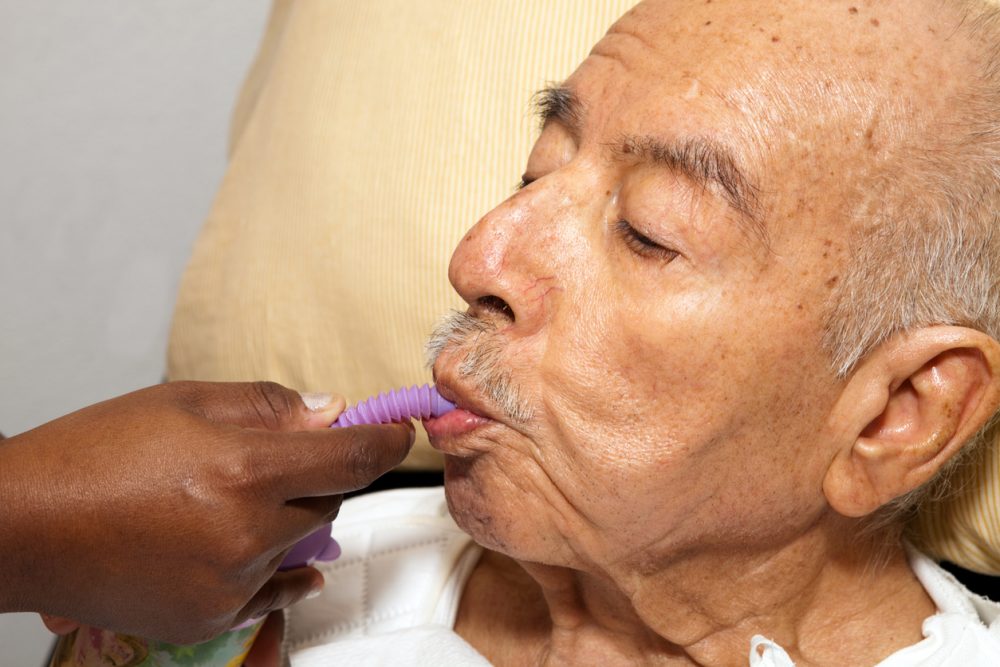In this blog for our Evidence for Everyday Allied Health series, Sarah Chapman looks at recent Cochrane evidenceCochrane Reviews are systematic reviews. In systematic reviews we search for and summarize studies that answer a specific research question (e.g. is paracetamol effective and safe for treating back pain?). The studies are identified, assessed, and summarized by using a systematic and predefined approach. They inform recommendations for healthcare and research. on interventions for swallowing difficulties in people with dementia and after stroke.
Blog updated 29 October 2021 and last checked 19 April 2023
Today is Swallowing Awareness Day, a day of campaigning to highlight how dysphagia (difficulties with eating, drinking and swallowing) affects people’s lives, and what speech and language therapy can do to help. There are recent Cochrane ReviewsCochrane Reviews are systematic reviews. In systematic reviews we search for and summarize studies that answer a specific research question (e.g. is paracetamol effective and safe for treating back pain?). The studies are identified, assessed, and summarized by using a systematic and predefined approach. They inform recommendations for healthcare and research. on interventions for dysphagia in people after stroke and people with dementia, so this seems a very good time to take a look.
Swallowing therapy for people after stroke
Dysphagia is common in stroke survivors, as are the complications that can result, including aspiration of food or fluid leading to chest infections and pneumonia, malnutrition and increased riskA way of expressing the chance of an event taking place, expressed as the number of events divided by the total number of observations or people. It can be stated as ‘the chance of falling were one in four’ (1/4 = 25%). This measure is good no matter the incidence of events i.e. common or infrequent. of infection. It lengthens the time spent in hospital and increases the risk of both dependency and death. Speech and language therapists can provide a range of interventions to treat dysphagia; compensatory approaches include modifying the consistency of food and fluid and postural adjustments, while rehabilitative methods include swallowing exercises and peripheral sensory stimulation.
A Cochrane Review Swallowing therapy for dysphagia in acute and subacute stroke (October 2018), comparing swallowing therapy with usual care for people with dysphasia up to six months after stroke, includes 41 studies with 2660 participants. The review authors explored the effects of swallowing therapy on death or dependency and other outcomesOutcomes are measures of health (for example quality of life, pain, blood sugar levels) that can be used to assess the effectiveness and safety of a treatment or other intervention (for example a drug, surgery, or exercise). In research, the outcomes considered most important are ‘primary outcomes’ and those considered less important are ‘secondary outcomes’. such as swallowing ability. They assessed eight types of stimulatory techniques ‐acupuncture, behavioural therapy, drug therapy, neuromuscular electrical stimulation, pharyngeal electrical stimulation, physical stimulation, transcranial direct current stimulation, and transcranial magnetic stimulation.
They found that swallowing therapy may slightly improve penetration aspiration scores and may slightly decrease pharyngeal transit time (by 0.23 seconds) as well as the number of people with dysphagia (344 vs 556 per 1000 people). It also probably reduces the length of hospital stay by about three days.
The evidence on swallowing ability and chest infections or pneumonia was very low-certaintyThe certainty (or quality) of evidence is the extent to which we can be confident that what the research tells us about a particular treatment effect is likely to be accurate. Concerns about factors such as bias can reduce the certainty of the evidence. Evidence may be of high certainty; moderate certainty; low certainty or very-low certainty. Cochrane has adopted the GRADE approach (Grading of Recommendations Assessment, Development and Evaluation) for assessing certainty (or quality) of evidence. Find out more here: https://training.cochrane.org/grade-approach, precluding firm conclusions about these outcomes, and the review authors note that information on swallowing therapy continues to be insufficient. We can hope that the next update of this review might have some more robust evidence, as the review authors identified 22 ongoing trialsClinical trials are research studies involving people who use healthcare services. They often compare a new or different treatment with the best treatment currently available. This is to test whether the new or different treatment is safe, effective and any better than what is currently used. No matter how promising a new treatment may appear during tests in a laboratory, it must go through clinical trials before its benefits and risks can really be known. which should add to the dataData is the information collected through research. when complete.
Swallowing difficulties in people with dementia
A Cochrane Review assessed the benefits and harms of Modifying the consistency of food and fluids for swallowing difficulties in dementia (September 2018). As with people after stroke who have swallowing difficulties, dysphagia in this populationThe group of people being studied. Populations may be defined by any characteristics e.g. where they live, age group, certain diseases. can increase the risk of aspiration pneumonia and death, as well as malnutrition and dehydration. Thickening agents are used to change the consistency of liquids along a spectrum of thickness from ‘water-like’ to ‘pudding-like’ and of course the consistency of food can also be altered.
The available evidence is disappointing. The review authors found no eligible trials on food modification, which is surely an important evidence gap. There were only two that looked at modifying fluids, both part of the same multi-centre trialA trial conducted at several geographical sites. Trials are sometimes conducted among several collaborating institutions, rather than at a single institution - particularly when very large numbers of participants are needed. , with participation in the second depending on the results from the first. The trial included people with dementia and people with Parkinson’s disease with or without dementia; only data on people with dementia were included in this review.
The first studyAn investigation of a healthcare problem. There are different types of studies used to answer research questions, for example randomised controlled trials or observational studies. was a cross-over study that gives only a snapshot of a moment in time, assessing the immediate effect on aspiration of honey thick and nectar thick liquids compared with regular liquids, using videofluoroscopy. The second compared the effects of nectar thick and honey thick liquids with a chin down head posture on pneumonia and adverse effects of the interventionA treatment, procedure or programme of health care that has the potential to change the course of events of a healthcare condition. Examples include a drug, surgery, exercise or counselling. , over three months. Honey thick liquids showed more positive effects on immediate elimination of aspiration on videofluorocopy but were associated with a higher incidenceThe number of new occurrences of something in a population over a particular period of time, e.g. the number of cases of a disease in a country over one year. of pneumonia in the second study. No deaths were reported to be ‘definitely related’ to the interventions.
The review authors’ bottom line us that whilst the very limited evidence currently available suggests that thickening fluids in the long-term may be associated with adverse events for some people with dementia, there is continued uncertainty about the benefits and harms of modifying the consistency of food or fluid for people with dementia who have dysphagia. They suggest that the lack of evidence to inform decisions about the use of thickened liquids should be discussed with family members.
Update (October 2021): a new Cochrane Review Screening for aspiration risk associated with dysphagia in acute stroke has been published and reveals an evidence gap. The authors conclude “we were unable to identify a tool that could accurately identify everyone with food and drink entering their airway, as well as detect all those who definitely did not.”
Join in the conversation on Twitter with @SarahChapman30 @CochraneUK or leave a comment on the blog.



More research is certainly needed. One (or two) swallow studies does not an evidence make! The recent changes to thickener formulation render this research largely irrelevant as the thickener used was a first-generation starch-based thickener, not the superior second generation ‘Clear’ xantham gum-based thickeners that are now in use. PrescQIPP has been advocating that only Clear thickeners are used for several years (PrescQUIPP Bulletin 100 Thickeners for Dysphagia). The results in this study suggesting increased development of pneumonia when using starch-based thickener cannot not be generalised to current practice with Clear thickeners.
It appears that quality of life with/without thickener when at risk of aspiration on thin fluids has not yet been researched which is an important gap to fill. In palliative care when comfort may outweigh risk management, thickened drinks (using Clear thickeners) may well be preferred.